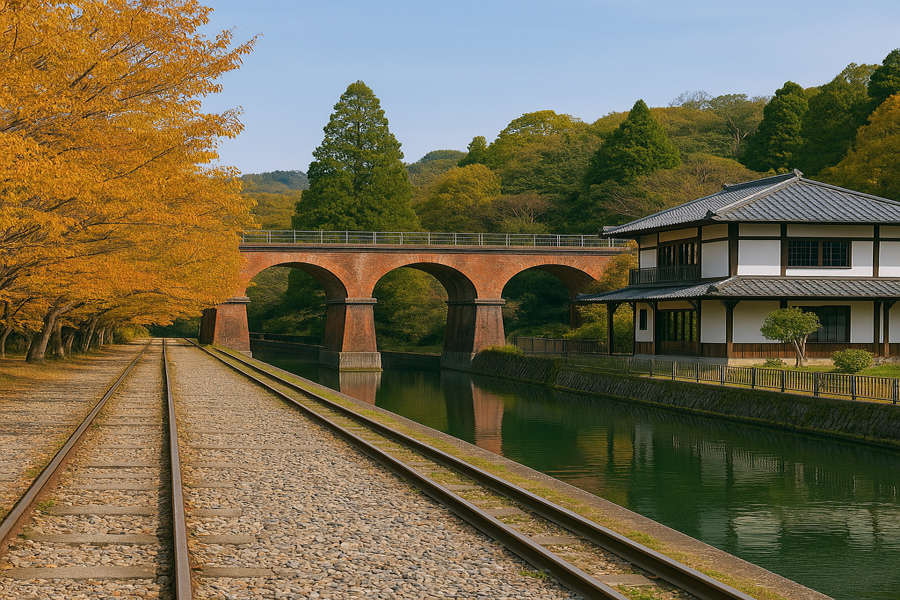At the foot of Kyoto’s eastern hills flows a quiet, graceful canal — the Biwako Sosui (Lake Biwa Canal).
Built in the late 19th century to bring water from Lake Biwa to Kyoto, it was one of Japan’s most ambitious civil engineering projects of the Meiji era.
More than 130 years later, this “waterway of life” still supports the city’s landscape and daily life.
The area around Nanzen-ji Temple and Keage has been transformed into a scenic walking path lined with trees that change color through the seasons — cherry blossoms in spring, deep reds and golds in autumn.
It’s just a short distance from Kyoto’s famous temples like Kiyomizu-dera and the lively Gion district, yet it remains a peaceful, often-overlooked escape where visitors can feel Kyoto’s quieter side and its long relationship with water.
A Meiji-Era Engineering Marvel
Construction of the Biwako Sosui began in 1885 and was completed in 1890.
The canal stretches roughly 20 kilometers from Lake Biwa in Otsu, Shiga Prefecture, to Kyoto’s Keage area.
It was designed to supply water for electric power, irrigation, transportation, and daily use, supporting Kyoto’s modernization after the capital moved to Tokyo.
Most notably, the canal powered Japan’s first commercial hydroelectric plant, which in turn drove Japan’s first electric railway — the Kyoto Electric Railway.
Thanks to the Sosui, Kyoto evolved from a declining old capital into a thriving modern city.
Biwako Sosui Memorial Museum — Discover the Canal’s Story
Located beside the Keage Incline, the Biwako Sosui Memorial Museum offers a fascinating look into the canal’s creation and the people who built it.
Through original blueprints, photos, detailed models, and videos, visitors can experience how Meiji-era engineers overcame enormous challenges to complete this ambitious project.
All exhibits include English explanations, making it easy for international visitors to understand Kyoto’s engineering heritage.
From the outdoor observation terrace, you can overlook the canal and the Keage Incline — a perfect spot to admire seasonal views, especially the autumn leaves.
It’s an ideal stop for families, couples, or anyone who loves learning history through real, living scenery.
Visitor Information
Biwako Sosui Memorial Museum
〒606-8437 Kyoto City, Sakyo-ku, Nanzenji Kusakawa-cho 17
Hours: 9:00 AM – 5:00 PM (Free admission)
Closed: Mondays (next day if Monday is a holiday), and Dec 29 – Jan 3
Highlights
1. Keage Incline
Perhaps the most iconic spot along the canal, the Keage Incline once used rails to move boats up and down the slope.
Today, the old tracks form a peaceful walking path.
In spring, it becomes one of Kyoto’s most photogenic cherry blossom tunnels, while early morning and sunset offer quiet, crowd-free moments.
2. Nanzen-ji Temple & Suirokaku Aqueduct
Inside Nanzen-ji’s grounds stands the Suirokaku Aqueduct, a red-brick bridge that channels the canal’s water.
Its European-style arches blend beautifully with the Zen temple’s calm atmosphere — a unique sight that perfectly captures Kyoto’s harmony between tradition and modernity.
3. Philosopher’s Path
Running along one of the canal’s branches, the Philosopher’s Path takes its name from philosopher Nishida Kitaro, who often strolled here in contemplation.
It’s a tranquil 2-kilometer walk shaded by trees, ideal for enjoying Kyoto’s changing seasons and quiet charm.
4. Biwako Sosui Boat Cruise (Seasonal)
During spring and autumn, you can experience the Biwako Sosui Boat Cruise, traveling part of the route between Lake Biwa and Kyoto.
Passing through tunnels and historic waterways, it’s a rare chance to see the canal from the perspective of those who once navigated it.
Access
-
Subway Tozai Line: Keage Station
- Keage Incline: right outside the station
- Biwako Sosui Memorial Museum: 10 min walk
- Nanzen-ji Temple: 10 min walk
-
Philosopher’s Path: 10 min walk from Nanzen-ji
Conclusion
The Biwako Sosui is a place where Kyoto’s quiet beauty meets its spirit of innovation.
It offers a different side of the city — less crowded, more reflective, and deeply tied to its natural surroundings.
Whether in spring blossoms, autumn colors, or winter stillness, this waterway reveals something new every season.
Take a slow walk, listen to the flow of water, and feel the story of Kyoto’s “Waterway of Life” beneath your feet.
